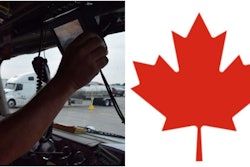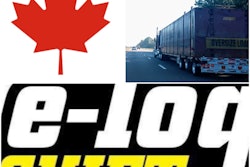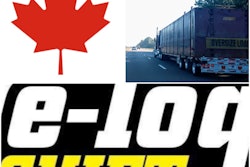The Canadian government announced this month it has finalized a mandate to require the use of electronic logging devices, setting a deadline of June 12, 2021, for carriers to replace their paper logs with ELDs.
The mandate is similar to that of the U.S. mandate, which took effect December 2017, particularly the Canadian mandate’s device requirements, meaning ELD providers won’t need to make new devices that comply with the mandate. Rather, the differences will be software-based, to ensure that ELDs track hours of service relative to Canada’s regulations.
Eric Witty, vice president of product at Trimble (formerly PeopleNet), says there will be little discernible difference in the way drivers will use ELDs in the two countries, despite differences in underlying hours of service regulations and differences like use of personal conveyance under Canadian rules.
However, there’s a key difference with Canada’s mandate — one that could have an effect on the U.S. market. Instead of allowing manufacturers to self-certify their devices, Canada will require a third-party body to certify that ELDs meet standards required by the ELD regulations. That standard could test the credibility of some devices listed in the Federal Motor Carrier Safety Administration’s ELD registry.
“It’s going to ripple through the entirety of the North American market, in my opinion,” says Travis Baskins, head of regulatory affairs for KeepTruckin, a prominent provider in the owner-operator market. “It’s going to serve as a filter,” he says, for providers whose hardware or software may not in fact meet federal standards, despite being self-certified in FMCSA’s registry.
For the Canadian market, that will translate to fewer device options, though all of the larger device manufacturers should easily meet the third-party certification process. The U.S.’ registry lists around 470 ELD providers. It’s unclear how many of those will clear Canada’s certification process.
“I guarantee [the Canadian market] is not going to get over saturated,” says Andy Oleson, senior solutions engineer at Platform Science, an ELD and telematics provider. “What we will end up seeing is [fewer] vendors in Canada, and that will also have some downfall into the United States.”
Likewise, Trimble’s Eric Witty says Canada’s more stringent certification process could shine a light on providers in the U.S. that don’t meed the proper ELD standards. “It’s not automatic that if [devices] comply with [U.S. regs] that they’ll comply with Canada, and vice versa. But that’s how people could look at it,” he says, adding that he’s “interested to see how FMCSA and others view” the process.
“If there’s a self-certified provider on their list and for some reason that provider is uncertified in Canada, I would think there would be a spotlight there,” he says.
The third-party certification process has not yet been established, but Canada is working to develop accreditation procedures for the third-party certifiers, says Baskins.
Another significant difference is with the roadside inspection process. Canadian ELDs will not be required to transmit a raw data (.CSV) file to inspectors that contains the driver’s log records for past seven days and the current day. In the U.S., devices can transfer the logbook file to officers wirelessly through web services and email or through Bluetooth and a USB drive. In any instance, the data file is sent to a cloud-based ERODs system that audits the logs.
The Canadian ELD rule only requires that devices be able to transmit a report of the driver’s past 14 days record of duty status. This report could be a PDF document that is sent to the officer at a roadside inspection via email, Bluetooth or a USB drive, explains Andy Oleson, senior solutions engineer at Platform Science, an ELD and telematics provider.
Carriers who operate cross-border will need to use a device certified via both countries processes. When making a true cross-border run, ELDs will likely only need to enter a different mode, either Canadian or U.S., to remain compliant. That switch could happen automatically, says Witty, based on location, though some devices may require input from the driver. Either way, ELDs will then update factors like remaining on-duty and drive time based on hours already operated during that shift and the hours of service regulations of each country.
According to information reported in the Canada Gazette, the number of regulated commercial vehicles in Canada is approximately 175,000. About 145,000 of these vehicles would have to have electronic logs, of which 80,000 do cross-border operations and as such are already compliant with the ELD regulation in the United States. This means that about 65,000 vehicles will need to install ELDs before June 2021. The Canada Gazette is the government’s regulatory docket, similar to the Federal Register in the U.S.
Also unlike the U.S. mandate, there will be no transitional period when carriers can use the less-sophisticated automatic onboard recording devices (AOBRDs) to comply with the mandate. The U.S. mandate allows carriers to use AOBRDs until December 2019. Canada’s mandate requires use of fully compliant devices by the June 12, 2021, deadline.











